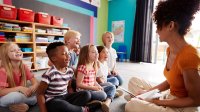Connecting SEL and Equity in Hybrid Learning Classrooms
Common social and emotional learning strategies also promote equity, contributing to all students’ feeling of belonging in school.
Your content has been saved!
Go to My Saved Content.Covid-19 has had a huge impact on students and teachers across the world. When the pandemic began, educators scrambled to ensure that both remote and face-to-face learners’ academic needs were being met. Over the last year, the priority has expanded from focusing largely on students’ academic learning to include equitable practices as well as social and emotional learning (SEL)—the same priorities many educators had in previous years.
Equitable practices include SEL engagement while focusing on cultural proficiency, creating a welcoming environment, using restorative practices, and encouraging student voice to ensure that all students get what they need regardless of their race, gender, or religious background. When students feel safe in the learning environment, they are much more capable of learning. In fact, students who learn in equitable environments and learn strategies that promote SEL practices have demonstrated improved classroom behavior, better attitudes, and increased academic performance.
Today, we find ourselves trying to balance effective instructional practices, addressing students’ social and emotional needs, and ensuring equitable practices in hybrid learning environments. The thought can be overwhelming, but balance can be achieved. Many educators employ common practices that can be expanded to provide an equitable environment for traditionally marginalized students.
4 SEL Practices That Promote Equity in Hybrid Learning
1. Improving relationships with and among students: Many teachers use conversation circles, a strategy that can be implemented during scheduled home room, morning meetings, or reading instruction. Conversation circles can also be practiced in remote environments to allow students to respond to current news headlines that focus on social justice or discrimination.
Teachers may feel more comfortable beginning such conversations by tying the topics to standards that align with history or government. Some states begin discussing social justice topics as early as first grade—for example, by looking at the life of civil rights activist Ruby Bridges. A text-to-self reflection after a reading assignment can also allow students to connect to the curriculum and learn more about different cultures and the experiences of their peers on a deeper level.
A focus on relationships helps teachers when grouping students for collaborative assignments. You may choose to place students with similar backgrounds together to reaffirm their beliefs and experiences, or create small diverse groups to ensure that students have an opportunity to collaborate with and learn from perspectives that are culturally different from their own.
2. Facilitating critical conversations: Encourage students to share respectfully using restorative questions. This proactively builds the students’ social and emotional capacity and teaches behaviors to prevent the use of punitive consequences that often contribute to a disproportionate number of behavioral referrals for Black and Brown students. When discussing assignments, or when sharing a difficult topic, the teacher can ask restorative questions to guide dialogue and walk students through their feelings.
If the conversation is needed as a response to disruptive behavior, the teacher can meet with the student to assist with understanding what caused their actions. Asking restorative questions can build the student’s communication skills and make them a part of the process. Sample restorative questions for behavior conversations:
- What did you think when you realized what happened?
- What impact has this incident had on you and others?
- What has been the hardest thing for you?
- What do you think needs to happen to make things right?
3. Creating a supportive classroom climate: Creating a supportive climate allows students to be actively engaged in classroom activities. Many teachers use the elbow partners strategy or assign collaborative projects. These strategies build community by providing opportunities for students from varying backgrounds to connect with each other. In a hybrid environment, remote learners can think as a group in breakout rooms while face-to-face learners turn and talk. After students have collaborated, they can share with the larger group.
This is extremely important for traditionally marginalized groups who may not share the same race or culture as their teacher, which has the potential to cause them to feel disconnected. Creating a supportive environment is also important for our remote learners who have less opportunities to socialize.
Including behavioral norms as part of the daily learning targets that require students to have cameras on for collaborative work, practice active listening, track the speaker with their eyes, or take turns to speak establishes SEL expectations for all learners regardless of their location or identity. Teachers can also outline expectations for student interaction during group assignments to create a safe environment.
4. Enhancing students’ self-awareness: Self-awareness is a foundational principle of an equitable learning space. Periodic use of self-reflection tools can help students and teachers be aware of beliefs and assumptions so that genuine relationships can be fostered in an inclusive and supportive space. As students and teachers share their own beliefs and experiences, they build trust with one another and are more ready for learning.
It’s important to consistently and intentionally use equitable strategies to best help our students now and in the future. Many of these strategies are common practices that can be extended to hybrid classrooms to ensure students from all backgrounds are heard and feel connected to their learning.
As our students continue with hybrid learning, it’s important to provide equitable instruction that supports every learner’s social and emotional needs to ensure that they feel included and supported every day.
